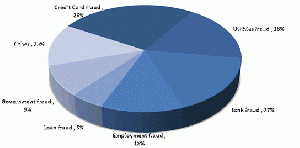Difference between revisions of "Online Identity Theft"
(→Ethics) |
(→References) |
||
| Line 37: | Line 37: | ||
2. Identity Crime Research and Coordination, Australasian Center for Policing Research. June 30, 2006. | 2. Identity Crime Research and Coordination, Australasian Center for Policing Research. June 30, 2006. | ||
| + | [[category: Information Ethics]] | ||
Revision as of 20:35, 29 November 2011
Online identity theft is a form of fraud where a criminal impersonates another person by obtaining personal information through the Internet. Typically, criminals steal another’s identity for financial gain such as applying for loans or credit cards without the person’s knowledge. Information gained from online identity theft includes but is not limited to social security numbers, signatures, names, addresses, phone numbers, credit card information etc. Because there are so many types of online identity theft (see pie chart below to the right), criminals have more options in how they commit identity theft online, resulting in more and more cases of this crime. In order to combat the increasing frequency of online identity theft, the government is making the consequences for online identity theft more severe.
Contents
Background
While the use of computers and Internet have given people new ways of accessing information, both have their negative consequences as well. In fact, one of the fastest growing crimes in the online environment is online identity fraud. Every time someone logs onto a computer, they are vulnerable to attacks from hackers, even with firewalls. The aftermath of being a victim of identity theft can be expensive and traumatic. Before computers and the Internet, criminals had to go “dumpster diving” or steal one's mail in order to gain his or her personal information. Now, through the use of modern technology, people open themselves up for a variety of risks to be hacked. All of the information that users share through social networks, online job and bank applications, and emails is vulnerable to theft by hackers from a remote location, making identity theft online far easier than in the real-world.
Types of identity theft
The most common forms of identity theft are listed below:
Financial Identity Theft
Financial identity theft, the most common form of online identity theft, occurs when someone illegally gains possession of another person's financial information, enabling the thief access to the victim's bank accounts and/or credit cards. Thieves have the ability to completely wipe the victim's entire bank account within hours or apply for numerous credit cards or loans using the victim's name and information. The rise in online banking and shopping has facilitated the increase in financial identity theft.
Criminal identity Theft
This occurs when a criminal gives another person’s name and personal information, such as a Social Security Number, to a law enforcement officer during an investigation. In some cases, the victim may not know their identity was stolen. In situations like this, the victim may not know there is a warrant out for his/her arrest and could lose unemployment or banking privileges. Criminals who steal another’s identity use the information it to open new accounts impersonating the victim.
Other
Other examples of online identity theft include medical identity theft, identity cloning, and business/commercial identity theft.
Causes
One way of obtaining information is by phishing. This involves sending spoof emails to people impersonating a business or institution. Spoof emails typically involve a user receiving an email to change his/her password after clicking the link. It takes the user to what appears to be a legitimate site; however it belongs to the thief. After the user enters his/her information, it is now in the hands of the criminal. Examples of this occur with online stores and financial merchants.
Effects
The effects of online identity theft are severe. People hesitate to use online banking, make financial transactions, and shop online. Identity thieves can cause financial and physiological damage. The financial damage can increase ones debt by thousands of dollars and severely damage the victim's credit score. Victims of identity theft claim they feel “violated” after having their identity stolen by an unknown person.
Prevention
In order to protect an identity, people need to protect their personal information, especially online. The most common information stolen online is account numbers, passwords, pin numbers, and Social Security Numbers. The most effective way is to never post this information in an online environment. However, there are professional companies with proven strategies to help people detect online identity theft. Likewise, many credit card companies have implemented fraud detection programs that help catch identity thieves by identifying fraudulent charges and contacting the cardholder.
Ethics
It is a federal crime to “knowingly transfer, possess, or use without lawful authority, a means of identification of another person”. Whether it's stealing credit card and Social Security Numbers stolen or bank account information, the government and media have made it clear that any form of identity theft is a crime. An individual is allowed to do what he or she pleases as long as it does not harm others in society. When a criminal hacks into another person’s account to steal personal information for their own gain, the victim is left hurt both financially and emotionally. Peoples' lives and welfare are harmed by identity theft if their money is stolen or they are unable to get a job. Stealing and using a person's information is considered unethical in most societies, and more attention should be placed on preventing this serious crime.
See Also
References
1. Internet Identity Theft - A Tragedy for Victims, Software and Information Industry Association. May 26, 2011.
2. Identity Crime Research and Coordination, Australasian Center for Policing Research. June 30, 2006.
